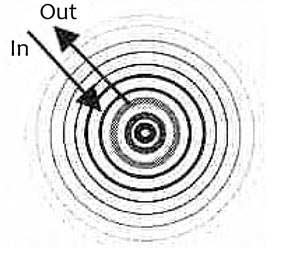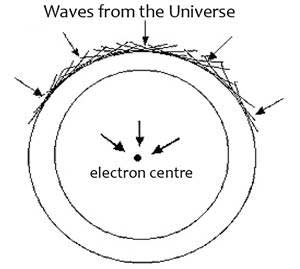Milo Wolff’s Universe of coherent quantum matter waves claims to overcome difficulties and paradoxes in conventional quantum theory and general relativity with applications in electronics and cosmology - Dr Mae-Wan Ho
Milo Wolff (now retired) is an American mathematical physicist and computer software expert with an extremely varied career [1]. His work included professorships in the Far East, at Massachusetts Institute of Technology, and on the Apollo moon craft navigation system. But his main claim to fame is the theory of the wave structure of matter, in which the electron is represented as consisting of two spherical quantum waves, one moving radially outward and another moving radially inward, resulting in standing waves at the centre of where the electron ‘particle’ is nominally located. These quantum waves extend throughout the universe; all waves mixing and contributing to one another. This simple representation is able to overcome major difficulties and paradoxes in conventional quantum theory and general relativity [2, 3].
Austrian physicist and philosopher Ernst Mach (1838-1916) proposed in 1883 that the law of inertia depended on all the matter of the universe [4]: “Every local inertial frame is determined by the composite matter of the universe...... [W]hen the subway jerks, it is the fixed stars that throw you down.” This became known as Mach’s principle.
Albert Einstein’s general theory of relativity was greatly influenced by Mach’s principle [5, 6], although it could not be included in the theory. The reason lies within the foundations of classical physics itself.
The foundations of classical physics follow from the equations of Scottish mathematical physicist James Clerk Maxwell (1831-1879), which represents matter as point charges and electromagnetic waves. English theoretical physicist Paul Dirac (1902-1984) never accepted point particles because Coulomb’s force law had to be corrected by ‘renormalization’ [7]: “This is just not sensible mathematics. Sensible mathematics involves neglecting a quantity because it turns out to be small, not neglecting it because it is infinitely large and you do not want it!” Austrian quantum physicist Erwin Schrödinger (1887-1961), likewise, proposed to eliminate point particles by using a quantum wave structure [8]: “What we observe as material bodies and forces are nothing but shapes and variations in the structure of space.”
In 1928, Dirac was looking for a connection between the conservation of energy given by E2 = p2c2 + m02c4 and Schrödinger’s quantum theory. He wrote [9]: “The new quantum mechanics, when applied to the problem of the structure of the atom with point-charge electrons, does not give results in agreement with experiment.” He used the concept of spin previously introduced by others including Austrian-born theoretical physicist Wolfgang Pauli (1900-1958), ending up with the Dirac equation that produces the right experimental results, but the magnitude of the spin (orbital angular momentum) is not a constant [9, 10].
American theoretical physicists John Archibald Wheeler (1911-2008) and Richard Feynman (1918-1988) tried to tackle the same problem by modelling the electron in 1945 [11] as spherical inward and outward electromagnetic waves in order to explain radiation forces, but failed because there are no spherical solutions of vector electromagnetic wave equations.
Milo Wolff’s wave atructure of matter [2, 3] replaces point particles and electromagnetic waves with spherical in-and-out scalar quantum waves (as opposed to Wheeler and Feynman’s vector electromagnetic waves). This quantum-wave structure for the electron possesses all the electron’s experimental properties and eliminates the paradoxes of quantum mechanics and cosmology. The non-existence of the material particle electron also removes the probabilistic interpretation of the wave functions, i.e., “God does not play dice” as Einstein said.
There are only two spherical wave solutions.
Outward wave Øout = (1/r) Øo eiwt-kr (1a)
Inward wave Øin = (1/r) Øo eiwt+kr (1b)
Where Ø is a scalar wave amplitude, w is the frequency 2pmc2/h, k is the wave number, r is the radius from the wave centre. These two waves can be combined in only two forms that become the structures of the electron-positron.
Electron Øin - Øout + CW spin (2a)
Positron Øout - Øin + CCW spin (2b)
CW (clockwise) and CCW (counter-clockwise) are rotation (spin) operators of the waves at the centre. Each wave pair contains an inward wave that rotates twice at the centre converting it to an outward wave (Figure 1) [3]. The reason is that the spherical waves must continually and smoothly change amplitude while changing direction of motion without twisting up space, and there is only one way to do this with either CW or CCW rotation.
It has been shown [12] that in spherical rotation, space returns to its initial state after two turns, and any exponential oscillator eiwt is a spinor. In spherical rotation, there is no fixed axis. Spherical symmetry is preserved because the centre of rotation is a point. It is significant that only 3-dimensional space has this unique property. Wolff realized that the exponential in-out waves were the real physical spinors satisfying the Dirac equation. The rotation and reversal of the inward wave amplitude at the centre can be represented by Dirac’s spinor algebra. One direction of rotation produces the electron, the other, the positron. That is why every charged particle has an anti-particle. Rotating an in-wave two turns each cycle produces an angular momentum of + h/4p, Dirac’s result. Both amplitude and direction of the waves are exactly opposite in the electron and positron, which is why experimentally their superposition produces annihilation.

Figure 1 The spherical waves of the electron and positron
The spherical out-waves of an initial electron encounter other electron waves. At each encounter, a signature of the initial electron is transferred to the out-waves of other electrons. The waves generated become a Huygens combination (a single wave-front) for the in-wave of the initial electron. This intermingled exchange of waves makes each particle like a 3-dimensional hologram of all others in the universe [2] (Figure 2).

Figure 2 Formation of the quantum in-wave
Energy transfer lacks a mechanism in the classical framework. Wolff [13] extended Mach’s principle to calculate the density of the wave medium as the summation of waves from each particle (1080) in our universe, each diminished by the inverse square law of distance. From the density of the medium, the amplitude of waves and motion of each particle can be calculated because wave velocity c is determined by the density of space. The energy transfer carried out by the quantum waves of the electron at speed c is seen by us as light waves.
Mach’s principle had been criticized because it appeared to require instantaneous action-at-a-distance. The answer is that the energy exchange due to quantum matter waves is going on all the time in empty space. That is the basis of instantaneous action-at-a-distance. Inertia is an interaction between an accelerated object and its surrounding space. The matter of the universe combines to tell the space medium what it is and in turn the medium tells all matter how to behave; this is essentially the same feedback loop implied in Einstein’s general relativity.
Wolff [13] also derived a relationship between the effective radius r of the electron, the radius R of the Hubble (expanding) universe, and the number of particles N in the universe, termed the Equation of the Cosmos.
r2 = R2/(3N) (3)
The value of r corresponds to the classical electron radius ~10-15 m. The waves of an electron have a finite maximum wave density at the centre, thus removing the need for renormalization that troubled Dirac, Feynman, and others.
Wolff provides a summary of the natural laws that can be derived from the structure of electron in Eq (2a, 2b) [3], some of which have been mentioned.
The electromagnetic consequence of Wolff’s wave structure of matter was investigated by Carver Mead, an engineer at California Institute of Technology in his prize-winning book, Collective Electrodynamics [14]. The book has become very popular in silicon-valley because it shows the correct ways to solve the electromagnetics of transistor circuits, replacing Maxwell’s equations. It is very likely to have many further applications in micro-chip design and micro-electronics.
Another area where the Machian nature of Wolff’s theory and relativistic mass finds important application is cosmology, especially in the intrinsic redshift of quasars [15] (Halton Arp’s Theory of Quasars Re-visited, and other articles in the series).
Article first published 03/03/16
Comments are now closed for this article
There are 7 comments on this article.
Tam Hunt Comment left 4th March 2016 06:06:17
Very interesting recent pieces on cosmology and physics, Dr. Ho. I hope there is a book coming out soon collecting your ideas into a coherent alternative picture of the universe.
Thomas Simon Comment left 4th March 2016 18:06:01
Dear Dr. Ho,
thank you for the very interesting piece. I have learned a lot from you about physics and the universe via ISIS during the past 10 years. I wish you fast and full recovery from your illness and hope that you will return to run ISIS and keep educating us.
All the best to you: Thomas
Dr Barry T Rubin Comment left 5th March 2016 00:12:52
Dear Dr Mae Wan Ho
This is a very interesting article and looks to have many ramifications in other fields of science.
I wonder whether the recent discovery of the exisitence of gravity waves can impact this treatment - gravity wave interactions with Wolff's theory of relativistic mass.
You are treasure for all you do - in science, art and humanity. I hope that you will recover from your illness as soon as possible with renewed strength and dedication.
Barry
Franz-Xaver Hipp Comment left 5th March 2016 21:09:49
Dear Dr. Mae Wan Ho. Thank you very much for this interesting article. Your articles over the past years have been always very interesting und helpful for a coherent alternative picture of the universe and the human being. I am very sad about your illness and I hope you will recover as soon as possible. All the best to you. Xaver
Marie-Paule Nougaret Comment left 16th April 2016 01:01:11
Dear Mae Wan, thank you for all the openings in our mind. Wish you the best
mpn
Todd Millions Comment left 10th April 2016 11:11:37
"-Place your hand in moving water.Feel the last of what was,and the first of what will be."-Leonardo Da Vinci. A whole technical approach of using tones to send and coordinate signal(not just Baudex telex) was used on the trans Canada microwave beam system in the 1950's to 1980's. Beat signals in this were used to diagnose and signal problems in the system as well.Not quite digital nor analog as these systems were defined.A different approach.
If this model had being developed into other areas-
Would this spin model have come into prominence more fully?earlier perhaps? Our tools can define us more than we think about.Our thought tools and mapping particularly so. If is such a large word. I will miss this site and its oft astounding content and commentators greatly. I wish I could have supported it better as was earned and deserved. Dr Mae-Wan Ho you are appreciated ,Honoured and Loved. I thank you and yours.Godspeed
Ted Comment left 22nd September 2016 23:11:37
Hi
Looks like we need a new scientific cosmological model to challenge the Big Bang theory.
Another website presents such a new model on what the universe is and compliments much of what is covered on this great website on the subject. The proposed model considers that the universe is an Electromagnetic Standing wave that propagates harmonically related standing waves. It is also proposed that this is all there is!